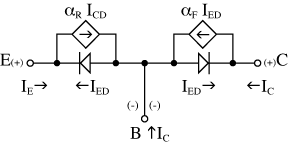
The invention of the transistor in 1947 at Bell Labs launched the electronics age. This small, three-terminal device allows current to flow between two of its terminals depending on the current or voltage applied on the third. It can be used for amplification, switching, modulation, and many other tasks that had only been possible by large, less robust vacuum tubes or mechanical relay switches. Over time, transistors became further miniaturized within integrated circuits (chips).
Sample mathematics of a Bipolar Junction Transistor (Ebers-Moll model):

Emitter current 
Collector current 
Base-internal current 
Where:
![]() is the common base forward short circuit current gain (0.98 to 0.998)
is the common base forward short circuit current gain (0.98 to 0.998)
![]() is the reverse saturation current of the base-emitter diode (on the order of 10-15 to 10-12 amperes)
is the reverse saturation current of the base-emitter diode (on the order of 10-15 to 10-12 amperes)
![]() is the thermal voltage (approximately 26 mV at room temperature ≈ 300 K)
is the thermal voltage (approximately 26 mV at room temperature ≈ 300 K)
![]() is the base-emitter voltage
is the base-emitter voltage
![]() is the base width
is the base width

